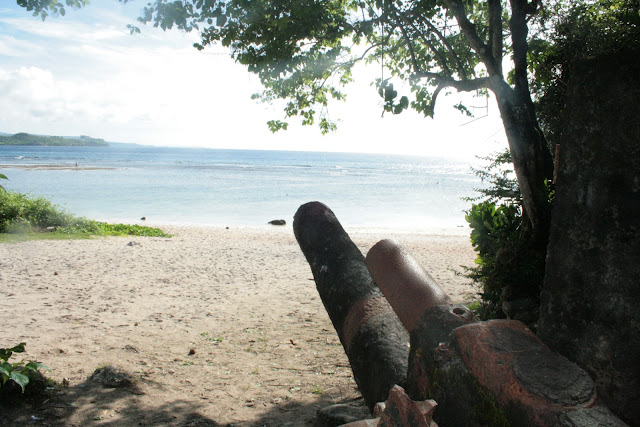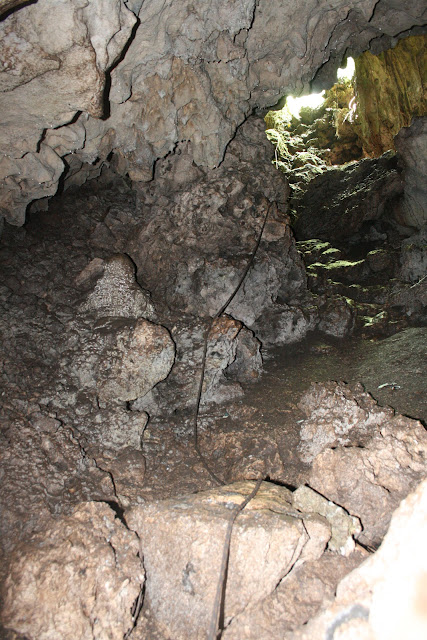Memorial Day -part II
In the late afternoon of Memorial Day I spent a couple hours at Asan Beach which is located on the west coast in the central part of the island. From a historical perspective, Asan Beach was one of the two primary beaches stormed by US troops as we recaptured Guam from the Japanese. This landing beach is 1 of 7 park units commemorating the WWII fighting on Guam. If you visit ever visit, you can travel from unit to unit and trace the 3-week battle that began on the beaches, spread inland, and swept across the island. This area is now a Nation Park: War in the Pacific National Historical Park.
 |
| This plaque welcomes visitors to this historic site. |
The picture below is a panoramic view take while standing on the beach which aces out to the north. The short peninsula extending out on the left side is Asan Point. There is a heptagonal monument commemorating the 50 Anniversary of this battle.
Countless markers are posted around this beach and field describing the events that took place during the War. One sign recounts the scene: "Mortar shells geysered the water as thousands of US Marines rode amphtraks and wade ashore on July 21, 1944. Jap forces-concealed in caves, machine-guns nests, pillboxes (to be described later), and artillery bunkers- resisted American assault fiercely. It took Americans all day to secure this narrow strip of sand. Though hard-won, the beachhead was not a final objective. As heavy fire continued to rain down from the surrounding ridges, Americans used Asan as a staging area for assaults on Jap strongholds [scattered throughout the island]". Below are pictures taken during the Battle. The first is an American demolition squad blowing up a cave. The second is a Jap 6-inch gun from the cliff which overlooks the beachhead.
The peninsula on the left in my above picture is the same view seen in the old photo in the signage below. This old photo was taken 1 hour after the first troops landed. In the foreground you can see a field dressing station in operation.
Another sign sits closer to that peninsula cautioning scuba divers. [The Mariana Islands are apparently some of the best diving in the world. The Mariana Trench,which runs along the east of the chain of islands, is the deepest part of the ocean in the entire world. The Trench is around 1600 miles long and is almost 7 miles deep. So divers flock to this region from all over the world.] After the Battle of Guam, US troops disposed of unexploded ammunition (ordnance) in the sea from the aforementioned peninsula. 50 years after, despite cleanup efforts, live ammo can still be found eroding on Guam, Saipan, and Tinian in hillside caves and on the ocean floor (which I have actually found in the forest-pretty cool!).
 |
| Troops disposing of ammo into the ocean after the Battle. |
This Park exists to honor the bravery and sacrifices of WWII and today a special memorial commemorates those who fought to recapture Guam. 3,033 US and Guam flags were arranged on the main battle field of Asan. Each US flag represents 1 of the 1,866 US Soldiers, Sailors, Marines, and Coast Guardsmen who were killed or died from woulds suffered during this Battle. Additionally, 1,167 Guam flags represent the Chamorro people who died during the Japanese occupation and the battle for Guam.
 |
| Main battlefield at Asan. 3,033 US and Guam flags represent those who gave their life for this territory. |
 |
| This is one torpedo presented fo Submarine forces in memory and recognition of the courage and sacrifice of subs whose heroism contribute significantly to the liberation of the Pacific. |
Below is a panoramic view of the entire field. This view is taken at ground level from the park's parking lot.
Maybe I should have presented this info at the beginning, but ohh well. The fields of Asan Beach have been influenced by several cultures which have contributed to the modern-day Guam.
1892-1900: Spanish government built a leprosy hospital here at Asan Point. In 1900, a typhoon destroyed that building.
1901-1903: The US government in the Philippines banished Filipino rebels to a prison camp at Asan Point.
1917: When the US declared war on Germany, Americans seized the crew of German auxiliary cruiser Cormoran and imprisoned them here in a tent camp surrounded by barbed wire.
1944: For 2 weeks, in July, US Navy pounded the fields here into a crater morass of mud and sand. Only a few topless coconut palms survived the bombardment.
1945-1967: Rows of barracks, called "Camp Asan", housed US Navy civilians employees.
1975: The abandoned "Camp Asan" became the reception center for thousands of Vietnamese refuges.
1976: Super Typhoon Pamela destroyed most of the buildings here and the navy subsequently cleared the rubble.
Today: this park stands to remember the fallen.
This last piece of the post tries to gives you a glimpse into the past as soldiers overtook the beachhead. Put yourself into the boots of our troops; it makes this section especially captivating (and terrifying)!
As you come off the beach and cross the open field pictured and described ealier, this hill/cliff/ridge is the first formation you see. Keep in mind that Japanese soldiers are buried in this hillside with huge cannons and machine guns. You should know that this hill sits by itself therefore retreat would not have been an option for the Japs. Like a cornered animal, the only choice was to 'fight to the death' and they did just that.
 |
| Taken from the left of Asan Ridge |
 |
| Same Ridge taken from the right side. |
Now you have stormed across the field, under constant barrage of Japanese bullets, and make it to the base of this 'hill' (at least it looks like a hill from afar). At you stand below it, the hill is quite steep and intimidating.
Jap soldiers are holed up in shallow caves, crevasses, and pillboxes
fighting for their life. In preparation for this expected invasion, Japs dug hundreds of caves like this throughout the island using forced labor (mostly Chamorro and Koreans). Caves and tunnel systems like this honeycomb the hills and ridges throughout Guam. The reason they did this was b/c they were outnumbered and planes bombarded them from above; so their best protection was to go underground. After Americans secured the beachhead, the battle became a deadly game of hide and seek. Below is that same cave as above taken during the battle (top picture), looking into (middle picture) and looking out from the cave (below picture).
I can't imagine being a US soldier ordered to take over this hill and then encounter Japs hiding in a dark cave like this. If you follow the path (up to the left of the above picture) which leads to the top of the hill where more Jap soldiers are waiting to kill you or die trying.
Toward the top of the hill are 2 bunkers barely 4 ft tall with a small window large enough to shoot through. These bunkers protected the paths leading up the ridge from the invading US.
 |
| View of the bunker from the path leading up the ridge. |
 |
| Inside view of the bunker. A 4ft tall x 3 ft wide space with a small gun window is all that constitutes this small but effective defense post. |
 |
| Currently, this bunker is only accessible by belly-crawling. The opening is a couple feet high. I assume it was not always this way and the elements have closed the opening. |
Today little is left now from what was surely a bloody and chaotic scene atop Asan Ridge. The few bunkers (pictured above), some scattered rusted gun/cannon barrels (below; see if can spot them all in the next 4 pictures), a beachfront defense post (below; fortified for tourists' protection), and overgrown foliage are all that remain.
 |
| Some discarded gun barrels and old pipes. |
 |
| 2 broken and discarded gun barrels. |
 |
| As is common with these old metal parts exposed to 60 years of weather wear, these barrels flake off much like tree bark. |
 |
| An old gun barrel buried in the earth. |
 |
| Large bunker facing the opposite bay on the backside of the hill. This bunker looks out on a different (but in close proximity) bay than Asan. |
Standing atop Asan Ridge, this is the view looking out onto Asan Beach and Asan Field. I'm sure the view 60 years ago was not as majestic and beautiful as the one I took below.
 |
| Asan Beach and Asan Field from the top of Asan Ridge. |
All
pictures presented in this post are property of the author. Unauthorized
use of these pictures is prohibited unless given explicit permission by
the author.
































